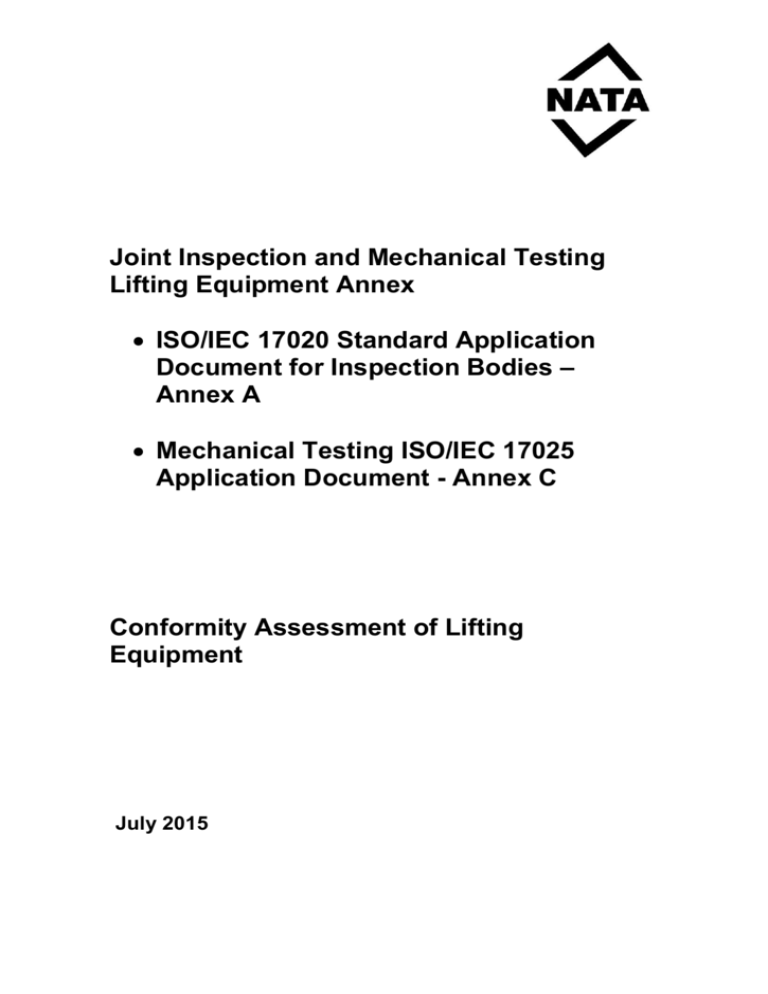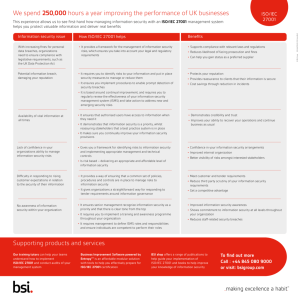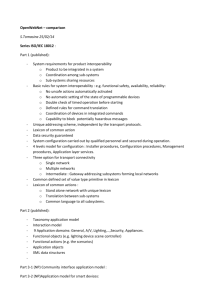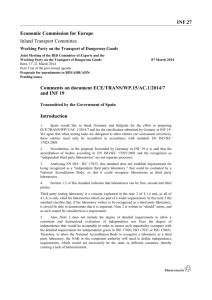Mechanical Testing Annex C: Lifting gear
advertisement

Joint Inspection and Mechanical Testing Lifting Equipment Annex ISO/IEC 17020 Standard Application Document for Inspection Bodies – Annex A Mechanical Testing ISO/IEC 17025 Application Document - Annex C Conformity Assessment of Lifting Equipment July 2015 © Copyright National Association of Testing Authorities, Australia 2014 This publication is protected by copyright under the Commonwealth of Australia Copyright Act 1968. NATA’s accredited facilities or facilities seeking accreditation may use or copy this publication or print or email this publication internally for accreditation purposes. Individuals may store a copy of this publication for private non-commercial use or copy a reasonable portion of this publication in accordance with the fair dealing provisions in Part III Division 3 of the Copyright Act 1968. You must include this copyright notice in its complete form if you make a copy of this publication. Apart from these permitted uses, you must not modify, copy, reproduce, republish, frame, upload to a third party, store in a retrieval system, post, transmit or distribute this content in any way or any form or by any means without express written authority from NATA. Inspection Annex A & Mechanical Testing Annex C: Conformity assessment of lifting gear Conformity assessment of lifting gear Scope This document provides interpretative criteria and recommendations for the conformity assessment of lifting gear. It is relevant to: inspection bodies working to ISO/IEC 17020 and performing inspection of lifting gear, and facilities working to ISO/IEC 17025 and conducting testing on lifting gear under Mechanical Testing. This document is applicable to both applicant and accredited facilities and replaces NATA Technical Circular 17. Applicant and accredited facilities must also comply with the relevant accreditation standard and field application documents (i.e. ISO/IEC 17020 for Inspection and ISO/IEC 17025 for Mechanical Testing) and any relevant field annexes, policies and/or technical circulars (refer to NATA procedures for accreditation). The headings of this Annex reference clause numbers from both ISO/IEC 17020 and ISO/IEC 17025. Since not all clauses require interpretation, not all clauses are referenced. With two standards being referenced, clause numbering may not be consecutive. Lifting gear accreditation standards Lifting and lifted equipment may be subjected to several forms of conformity assessment during its design, fabrication, at the time of supply and/or while inservice. Conformity assessment can involve design verification, verification of construction, application of proof loads, application of breaking loads on samples drawn from a batch, visual inspection of equipment in-service, assessment of functionality and proof loading of equipment in service. With regard to proof load testing, this requires the pre and post test examination of the equipment to establish any deterioration or permanent change in the equipment that is attributable to the application of the load. Inspection is defined as: Examination of a product design, product, process or installation and determination of its conformity with specific requirements or, on the basis of professional judgement, with general requirements. (ISO/IEC 17000, Clause 4.3) Testing is defined as: Determination of one or more characteristics of an object of conformity assessment according to a procedure (ISO/IEC 17000 Clause 4.2) These definitions are critical in order for NATA to consistently apply and assess a facility against either standard or both. In many cases the distinction between inspection and testing is not reflected in the terminology used in the industry. Accordingly, the following sections allow facilities to determine the appropriate standard, or standards, against which they should seek accreditation for the activities they perform. July 2015 Page 3 of 8 Inspection Annex A & Mechanical Testing Annex C: Conformity assessment of lifting gear Inspection bodies Facilities accredited to ISO/IEC 17020 may perform functional load testing within the scope of their accreditation when the applied loads are equal to, or less than, the working load limit of the equipment under inspection. Loading of items in excess of the working load limit (WLL) (so-called “proof” loading) is outside the scope of accreditation for inspection bodies, except where the specified technical documents explicitly require ongoing verification by loading above the WLL during in-service inspections. Facilities must be accredited to ISO/IEC 17025 to be able to issue NATA-endorsed reports for all other proof loading tests above the WLL. The scope of accreditation of inspection bodies who conduct functional load testing will include a statement that such load testing is limited to loads below and including the WLL of the equipment under inspection. Where the exception is relevant, the scope of accreditation will explicitly identify the relevant technical documents used. Testing laboratories Facilities accredited to ISO/IEC 17025 are able to examine equipment before and after testing and, if appropriate, may reject equipment on the basis of examination only. However, acceptance of equipment as fit for service without subjecting the equipment to a load test (i.e. acceptance by inspection only) is outside the scope of accreditation for testing facilities and to be able to issue NATA-endorsed reports for this work such facilities must also be accredited to ISO/IEC 17020. Accreditation criteria The following information sets out the accreditation criteria, recommendations and guidance relating to Personnel, Equipment, Product-specific criteria and processes / procedures within the facility. Personnel criteria (ISO/IEC 17020 Clause 6.1, ISO/IEC 17025 Clause 5.2) Vision tests All personnel involved in the assessment of lifting gear must satisfy the following requirement for visual acuity every two years. The person shall be able to demonstrate clear near vision (corrected or uncorrected) by being capable of reading a row of letters of sufficiently fine print (Jaeger No. 1 or equivalent type, or finer) at a distance of 300 mm. This requirement is based upon AS 3978. Colour vision may also be relevant and a one-off confirmation of colour vision performance should be conducted and records kept. Equipment criteria (ISO/IEC 17020 Clause 6.2, ISO/IEC 17025 Clause 5.5) Records of proof load determinations for ancillary equipment used for conducting tests (e.g. rings, links, chain) must be kept. Regular inspections of the equipment should also be undertaken. These items should be marked so as to prevent any possible confusion with similar equipment provided by clients. Where rigs are needed to facilitate handling of items for testing or inspection (e.g. container stands, reaction frames), the facility should hold records identifying a working load limit for such rigs. July 2015 Page 4 of 8 Inspection Annex A & Mechanical Testing Annex C: Conformity assessment of lifting gear Product specific criteria Fibre rope slings Accreditation is available for proof tests upon fibre rope slings. The facility seeking accreditation must develop a testing procedure for the items under test. Specific matters, for example loading rates, must be considered. Plate clamps Accreditation is available for proof tests upon plate clamps. AS 4991 gives specific details for the testing of plate clamps. The hardness of the test plates used shall either be determined by a NATA accredited facility (or a facility accredited by an accreditation body signatory to the ILAC Mutual Recognition Arrangement) or shall be determined in-house with supporting records. If in-house hardness testing is conducted the hardness testing equipment shall be calibrated and the requirements for hardness testing as detailed in Mechanical Testing Annex B: Metals must be met. The condition of test plates shall be examined regularly to ensure their continued suitability (i.e. have not been excessively damaged by plate clamps). The facility shall document acceptance criteria for the test plates and hold records of the condition checks and maintenance / replacement of test plates. These items should be marked so as to prevent any possible confusion with similar equipment provided by clients. Serial hoists Operational tests on serial hoists shall include both raising and lowering under load. When using a hydraulic system the load shall be maintained between (-5%, +20 %) during the lowering and raising procedure. Slings The legs of multi-legged slings shall be tested in accordance with the relevant standard taking into consideration the operating angle. The head link shall not be overloaded if legs are tested simultaneously using a load equalising device. When calculating the force to be applied consideration shall be given to the resolution of forces through the load equalising device. Determination of Centre of gravity of structures/weighing of structures In addition to the usual requirements associated with procedures, procedures describing the determination of centre of gravity and/or weight of structures must detail: how allowance for friction is made; how the lift is undertaken; the type of beam to be used; and how allowance for environmental influences is made. July 2015 Page 5 of 8 Inspection Annex A & Mechanical Testing Annex C: Conformity assessment of lifting gear Procedural criteria (ISO/IEC 17020 Clause 7.1, ISO/IEC 17025 Clauses 5.4 and 5.8) Marking and identification of items In the case of small items it may not be feasible to tag, mark or otherwise identify each item. The client shall be consulted to establish protocols for handling small items. Where the identification of an item is refreshed, changed or revised (e.g. by retagging, changing colour dots or replacement of data plates) all changes must be reported to the client. Testing parameters Critical components shall be marked or measured to ensure permanent deformation can be quantified. If measurements are made they must be recorded. There are a number of methods for determining deformation of lifting equipment. The preferred method must be identified in facility documentation, either under a general testing procedure or within product-specific testing procedures. When an item is submitted for proof testing and it is not covered by an Australian standard, or a standard written by another standards writing body, it must either be accompanied by engineering computations or be permanently marked with its capacity, safe working load or working load limit, as applicable. Where a permanent marking on the item is the basis for determination of proof load or force, the customer shall provide the facility with detail of the authorisation for the permanent marking, and this basis shall be stated on both test record and report. Where this detail is not available, the work cannot be covered by the scope of accreditation. On-site testing Accreditation is available for on-site proof load testing of items and fixtures. The facility must possess suitable equipment and procedures. The scope of accreditation is structured to reflect the on-site testing capability of the facility. Test load hold times When test load hold times are not specified by the standard, the following hold times shall be used as a minimum: Chain slings / fittings 10 seconds Other lifting equipment 20 seconds Review of requests, tenders and contracts (ISO/IEC 17025 Clause 4.4, ISO/IEC 17020 Clause 7.1) Customers’ requests shall be reviewed to ensure that the characteristics, which are to be inspected, measured or tested, together with any acceptance criteria, are clearly and unambiguously stated. Where the item of lifting gear is required to be accompanied by engineering computations (e.g. it is not covered by an Australian or recognised overseas standard1) the facility shall check to ensure July 2015 Page 6 of 8 Inspection Annex A & Mechanical Testing Annex C: Conformity assessment of lifting gear that all necessary information has been supplied before performing any conformity assessment work. The review shall include physical, personnel and information requirements and resources and shall confirm that personnel have the skills and expertise necessary for the satisfactory performance of the work requested. 1 Note : ‘Recognised overseas standard' is a standard published by a recognised standards writing body such as international/national standards organisations, specifying organisations such as the American Society for Testing and Materials (ASTM) and government agencies. Safety-related issues shall be considered during the review of requests, with particular attention to matters relating to access, loading and the possible consequences of failure. Test records and reports (ISO/IEC 17020 Clauses 7.3 and 7.4 and ISO/IEC 17025 Clauses 4.13.2 and 5.10) When testing individual components of an assembled product (e.g. multi-legged sling) or a number of items of the same description, the actual load applied to each component or item must be recorded in test records. Test certificates may detail only the overall force or load applied. For tests such as proof tests on items, the design and manufacture of which are not covered by an Australian or recognised overseas standard1, the test record and report shall each state the test configuration and the basis upon which the test load or force, and the method of its application is derived. Common equipment performance checks (ISO/IEC 17020 Clause 6.4, ISO/IEC 17025 Clause 5.5.2) Facilities are responsible for establishing their own equipment assurance program. This is to ensure that all equipment used satisfies the need to produce consistent and reliable and, where appropriate, traceable results. In doing so facilities must ensure that where methods writing bodies have included equipment calibration and checking intervals in standard methods that these intervals must be followed if the methods are covered by the accreditation. Facilities should refer to the guidance documents available for equipment (and General Equipment Table) for further information on calibrations and checks on equipment. References This section lists publications referenced in this document. The year of publication is not included as it is expected that only current versions of the references shall be used. Standards AS 2193 Calibration and classification of force measuring systems AS 3978 Non-destructive testing - Visual inspection of metal products and components AS 4991 Lifting devices ISO/IEC 17000 Conformity assessment - Vocabulary and general principles July 2015 Page 7 of 8 Inspection Annex A & Mechanical Testing Annex C: Conformity assessment of lifting gear ISO/IEC 17020 Conformity assessment – Requirements for the operation of various types of bodies performing inspection ISO/IEC 17025 General requirements for the competence of testing and calibration laboratories Amendment Table The table below provides a summary of changes made to the document with this issue. Section or Clause Amendment Equipment criteria Criteria for ancillary equipment has been simplified. Standards Additional reference standards included. July 2015 Page 8 of 8





